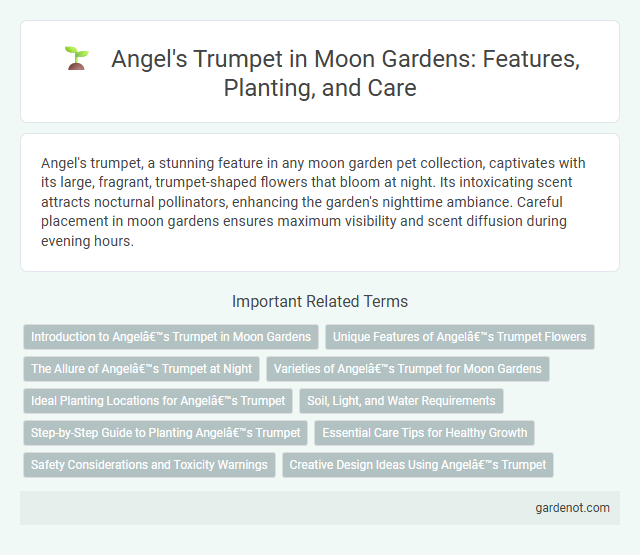Angel's trumpet, a stunning feature in any moon garden pet collection, captivates with its large, fragrant, trumpet-shaped flowers that bloom at night. Its intoxicating scent attracts nocturnal pollinators, enhancing the garden's nighttime ambiance. Careful placement in moon gardens ensures maximum visibility and scent diffusion during evening hours.
Introduction to Angel’s Trumpet in Moon Gardens
Angel's Trumpet (Brugmansia spp.) is a striking feature in moon gardens due to its large, pendulous, trumpet-shaped flowers that emit a captivating fragrance at night. This tropical plant thrives in moon gardens by adding a mystical ambiance with blooms that glow softly under moonlight, attracting nocturnal pollinators like moths. Angel's Trumpet requires well-drained soil and partial shade, making it an ideal choice for creating a serene and enchanting nighttime garden environment.
Unique Features of Angel’s Trumpet Flowers
Angel's trumpet flowers, known for their large, pendulous blooms, emit a powerful, sweet fragrance that intensifies during the evening, attracting nocturnal pollinators like moths. The blossoms display a wide range of vibrant colors, including white, yellow, pink, and orange, often with a trumpet-like shape that can reach up to 20 centimeters in length. These unique floral characteristics not only contribute to the moon garden's enchanting nighttime atmosphere but also play a crucial role in its ecological interactions.
The Allure of Angel’s Trumpet at Night
Angel's trumpet (Brugmansia) captivates nocturnal gardens with its large, pendulous flowers that emit a rich, intoxicating fragrance after dusk, attracting pollinators like moths and bats. The blossoms glow softly under moonlight, creating a mystical ambiance that enhances nighttime garden aesthetics. Its alluring scent and dramatic silhouette make Angel's trumpet a prized centerpiece for moon gardens and evening landscapes.
Varieties of Angel’s Trumpet for Moon Gardens
Angel's Trumpet (Brugmansia) offers diverse varieties ideal for Moon Gardens, including Brugmansia aurea with large, fragrant yellow flowers, and Brugmansia suaveolens known for its dense clusters of white and pink blooms. These night-blooming plants emit a sweet, intoxicating fragrance that enhances the moonlit ambiance, attracting nocturnal pollinators such as moths. Cultivating multiple varieties enriches the garden's sensory experience, combining striking trumpet-shaped blossoms with captivating scents unique to evening settings.
Ideal Planting Locations for Angel’s Trumpet
Angel's Trumpet thrives in well-drained, fertile soils with partial to full sunlight, making it ideal for garden beds, patios, and pergola-adjacent areas where indirect light promotes vibrant blooms. This tropical shrub prefers temperate climates, so planting it in sheltered spots away from strong winds helps preserve its delicate flowers. Incorporating Angel's Trumpet near water features or shaded walkways enhances both its aesthetic appeal and ecological compatibility.
Soil, Light, and Water Requirements
Angel's trumpet thrives in well-draining, fertile soil rich in organic matter, ensuring optimal growth and vibrant blooms. This plant prefers partial shade to full sun, with at least 4-6 hours of indirect light daily for best flowering performance. Consistent watering is essential, keeping the soil moist but not waterlogged, especially during dry spells or growing seasons.
Step-by-Step Guide to Planting Angel’s Trumpet
Angel's trumpet thrives in well-drained, fertile soil enriched with organic matter, ideally planted in a location receiving partial to full sunlight. Start by soaking seeds overnight to enhance germination, then sow them about 1/4 inch deep, maintaining soil moisture without waterlogging. Regular watering and applying a balanced fertilizer every two weeks support healthy growth, while pruning encourages bushier blooms throughout the growing season.
Essential Care Tips for Healthy Growth
Angel's trumpet thrives in well-drained, fertile soil with consistent moisture, avoiding waterlogged conditions to promote healthy growth. Providing partial shade protects the plant from intense afternoon sun, preventing leaf scorch and encouraging abundant flowering. Regular feeding with a balanced, nitrogen-rich fertilizer during the growing season supports vigorous development and vibrant blooms.
Safety Considerations and Toxicity Warnings
Angel's trumpet (Brugmansia) contains potent alkaloids such as scopolamine, hyoscyamine, and atropine, making all parts of the plant highly toxic if ingested. Handling with gloves is recommended to avoid skin irritation and accidental poisoning, while keeping it out of reach of children and pets is critical due to its toxic potential. Awareness of symptoms like dizziness, hallucinations, and rapid heartbeat is essential for prompt medical attention after exposure.
Creative Design Ideas Using Angel’s Trumpet
Angel's trumpet, with its dramatic, trumpet-shaped blooms and lush foliage, serves as an enchanting focal point in moon garden designs, offering a captivating blend of form and fragrance under the night sky. Incorporating Angel's trumpet in tiered planting schemes enhances vertical interest, while pairing its white or pastel blossoms with soft lighting accentuates its ethereal glow, perfect for creating mystical, sensory garden experiences. Using Angel's trumpet as a backdrop or centerpiece alongside night-blooming jasmine and silver-leaved plants intensifies the moon garden's visual and aromatic appeal, elevating the overall ambiance.
Angel’s trumpet Infographic

 gardenot.com
gardenot.com